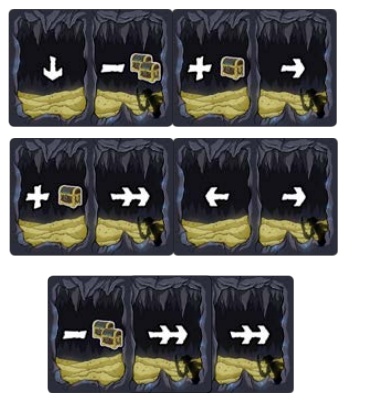Greedy Dragons: A Card Game of Puzzles, Take-That, and Divvying Up Loot

Dragons have never been known for sharing, which makes divvying up the hoard a tricky proposition.
Play cards to try to manipulate the distribution of loot in different ways each round, taking treasure cards and forcing other players to lose some, all while trying to keep an eye on your opponents and making sure they don’t force you to lose treasure too.
Gameplay
At the start of Greedy Dragons, the treasure chest cards are shuffled and five are dealt to each player facedown. Another twenty five are placed facedown, in a spread-out pile in the center, forming a draw pile, and the rest are returned to the box. Next the lair cards are shuffled and one random one is placed faceup in front of each player. This is the start of each player's tableau. Each player is then dealt two lair cards to form their hand.
Each round, players play one lair card, either onto their own tableau or onto any other player's. Each lair card is divided into two sections. Each section will show either arrows or one to two treasure chests with a plus or minus sign. When playing a lair card in a tableau you can play it adjacent to another lair card, or covering one or two sections of one or two lairs cards. No tableau can be longer than four sections wide, so you will usually have to cover a portion of a tableau in order to add a new card to it.
After each player has played one card, each tableau is resolved. In each tableau the number of treasure chests is added together, and then affect a player for each arrow shown. So, if there are plus two treasure chests, and one arrow pointing to the left and one to the right, the player to the left takes two treasure chests from the draw pile, and the player on the right takes two treasure chests from the draw pile. If there had been two arrows pointing to the left in that example, then the player to the left would have taken four treasure chests. If the sum of chests is a negative number, players have to discard treasure cards to the draw pile. There are also some arrows that indicate the player two to the right of the tableau or two to the left. Treasure cards are drawn and discarded facedown, and cannot be looked at during the game.
Once all tableaus have bene resolved, each player draws a new card and another round begins. Once the deck of lair cards is empty, the game ends, players reveal their treasure cards, tally their points, and the player with the most points wins.

Review
Greedy Dragons is a fast-playing, easy to learn strategic puzzle, in which you have plenty of options every turn, and focus as much on taking treasure away from other players as you do on earning more yourself.
You have to stay aware of not only your own tableau but other players’, and keep an eye on their pile of treasure cards. While you don’t have many lair cards to choose from when playing, you have many tableaus, as well as different positions you can lay a card in each one.
The treasure cards come in a range of point values from zero to three and even one unique card that is worth ten points. Since you don’t play with all the treasure cards each game, you never know what’s in there, and this leaves a lot of uncertainly right up to the end. If you like a little less randomness however, the rulebook has suggestions for which cards to remove, so you can adapt it to your play preference.
Greedy Dragons is definitely at its best with four or more players. In a two player game there is a dummy hand, and with three players, it’s extremely easy to be targeted by multiple arrows on both fronts — you are vulnerable to both single and double arrows from both players.
If you are looking for a light card game that still has some interesting strategy or enjoy games with puzzle-like aspects, Greedy Dragons may be right up your alley. There’s a good bit of take-that elements in the game, but it feels quite satisfying to manipulate a tableau to your best advantage.
Pros: Fun puzzle-like mechanics, lots of options each turn while still keeping simple rules, ability to adjust randomness of the treasure cards
Cons: Two to three players is not as enjoyable
Disclosure: we received a complimentary review copy of this game.









